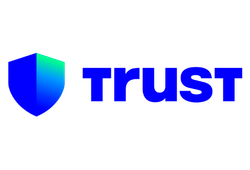
Free Airdrop Season 7 is LIVE! Answer fun questions or do simple tasks to earn rewards from the $30K BitDegree prize pool. Participate Now ! 🔥
To explore the world of cryptocurrencies, you need to find the right wallet to safeguard your assets. There are many great options, including Ledger Nano X, Coinbase Wallet, or Binance Wallet. However, in this Trust Wallet review, we'll look into one that's gained traction for its user-friendly interface and extensive support for diverse digital currencies.
I'll try to answer all your burning questions, including, "Is Trust Wallet legit?", "Is Trust Wallet a cold wallet?", "Is Trust Wallet safe?", and, if it is, "How safe is Trust Wallet?". So, without further ado, let's delve into each of these questions to get a comprehensive understanding of the Trust Wallet and its reliability as a tool for digital asset management.
Verdict at a glance: The Trust Wallet offers a secure and user-friendly mobile and website extension-based wallet. Its strengths lie in robust safety measures, a diverse range of cryptocurrencies and NFTs, and an easy-to-navigate interface. The wallet enables seamless crypto swapping and purchasing directly within the app, and it also supports in-wallet staking. However, out of millions of supported crypto assets, some might not be the most legitimate. Also, the Trust Wallet does not employ two-factor authentication.
Pros
- Free to use
- Supports millions of crypto assets and NFTs
- Suitable for beginners
- In-wallet swapping, staking, and crypto buying
Cons
- No two-factor authentication
- Questionable reliability of some supported crypto assets
Table of Contents
- 1. What is the Trust Wallet?
- 2. Trust Wallet Review: PROS
- 2.1. Encrypted and Audited Non-Custodial Wallet
- 2.2. Millions of Cryptocurrencies and NFTs Supported
- 2.3. Seamless User Experience
- 2.4. Swapping and Buying Directly Within the Trust Wallet
- 2.5. In-Wallet Staking Options
- 3. Trust Wallet Review: CONS
- 3.1. Questionable Legitimacy of Some Supported Crypto Projects
- 3.2. No Two-Factor Authentication (2FA)
- 4. Trust Wallet Fees
- 5. How to Create a Trust Wallet?
- 6. Conclusions
What is the Trust Wallet?
Let's start off this Trust Wallet review by talking about what this platform is – and what it isn't. That way, you'll know the answers to questions like "Is it the same as the Binance Wallet?" or "Is Trust Wallet legit?".
The Trust Wallet was launched in 2017 but it was acquired by Binance in 2018. When it comes to legitimacy, it provides a secure haven for managing your digital assets. The Trust Wallet encrypts your crypto keys and ensures that you have exclusive control over your funds. Also, it prioritizes user privacy by abstaining from storing any personal information.
Functionally, the Trust Wallet serves as a vital link, connecting users to various blockchains housing their cryptocurrencies in distinct addresses. Yet, crucially, the Trust Wallet does not directly manage or retain control of any user's crypto holdings because it's non-custodial.

Is Trust Wallet a cold wallet? No, the Trust Wallet is not a cold wallet – it's a hot (software) wallet. This means that, even though your private keys are entirely in your custody, the wallet itself is connected to the internet[1].
Beyond its role in storing crypto, the Trust Wallet also enables sending, receiving, trading, and staking crypto. Besides that, it can be used to connect to a variety of decentralized applications (dApps).
However, since the Trust Wallet belongs to Binance, many get confused and think that it's the same as the Binance Wallet or the Binance Web3 Wallet.
In reality, it is not. The Trust Wallet, the Binance Wallet, and the Binance Web3 Wallet are three separate products.

The Binance Wallet is a wallet that's built into the Binance crypto exchange. This wallet provides secure storage for digital assets and is used when engaging with the exchange (trading, using its earning features, and so on).
Meanwhile, the Binance Web3 Wallet is an MPC-powered self-custody wallet that's also built into the Binance exchange (or, to be more specific, the Binance mobile app). Unlike the Binance Wallet, it focuses on connectivity to various dApps. Though, it also allows in-wallet swaps and has earning features.
The Trust Wallet, however, is a completely separate hot wallet. It targets users seeking unfettered access to diverse dApps and tokens without the necessity of integrating with Binance's trading accounts. So, it's not actually a part of the Binance ecosystem; Binance is simply the parent company of the Trust Wallet.
Trust Wallet Review: PROS
Now that you're all set, let's delve into the selling points I want to highlight in this Trust Wallet review. In doing so, you'll understand the features that make this particular software wallet a preferred choice among crypto enthusiasts.
Encrypted and Audited Non-Custodial Wallet
People who search for Trust Wallet reviews often want to find answers to such questions as, “Is Trust Wallet legit?”, “Is Trust Wallet safe?”, and “How safe is Trust Wallet?”.
Safety should be the main priority of any crypto platform, and the Trust Wallet knows that. With a vast user base, exceeding 70 million individuals globally, the Trust Wallet prides itself on a proactive approach to safeguarding assets. Since its establishment in 2017, it has been rigorously tested and fortified with multiple layers of protection to ensure the integrity of users’ assets remains steadfast.
Central to its security architecture is encryption. The Trust Wallet employs robust AES encryption for private keys, securely stored on users’ devices, and strictly refrains from transmitting them over the internet or exposing them to external entities. The passcode you set? It undergoes hashing and is securely stored within a tamper-proof key store.
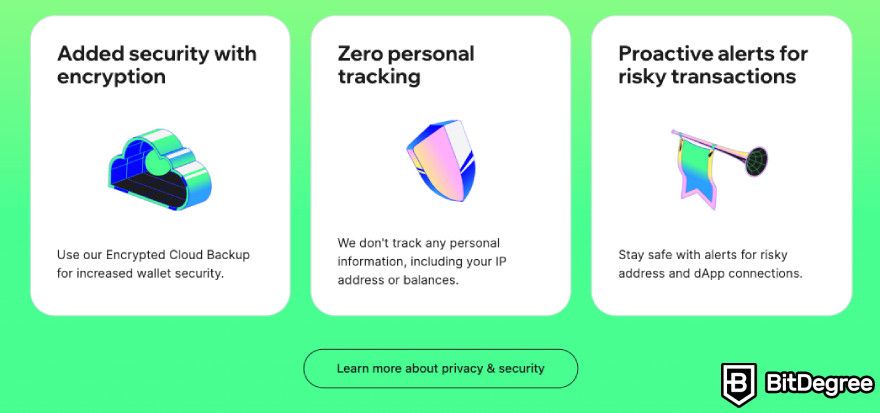
To uphold its commitment to security, the Trust Wallet undergoes regular audits by reputable third-party firms like CertiK. These audits serve to identify and promptly address potential vulnerabilities. Furthermore, continuous security monitoring remains an integral part of Trust Wallet’s operations, ensuring timely identification and mitigation of risks, all while keeping users informed through in-app notifications.
Another remarkable aspect praised in many user Trust Wallet reviews is its respect for user privacy. There’s no tracking of personal information, IP addresses, or even account balances. While the Trust Wallet secures the wallet itself, the ownership and control of private keys exclusively belong to the user.
In other words, as you already know, the Trust Wallet operates as a non-custodial wallet, ensuring it doesn't retain user data or necessitate a Know Your Customer (KYC) verification during the account setup process.
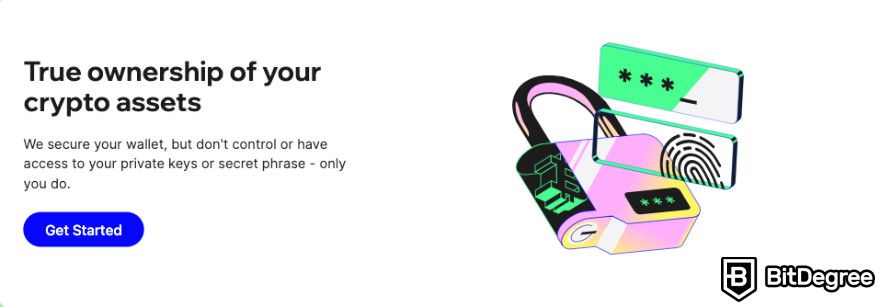
Beyond mere asset protection, the Trust Wallet also keeps a watchful eye on users’ behalf. Proactive alerts are issued for transactions deemed risky, empowering users with information about potentially dubious activities.
So, is Trust Wallet safe? Yes, it seems that it is. But how safe is Trust Wallet? Well, definitely not as safe as a cold wallet like Ledger Nano X, but as far as hot wallet safety goes, it's pretty safe.
Speaking of cold wallets, note that you can connect your Trust Wallet to Ledger devices to store your private keys completely offline. You can also easily access your Ledger wallet via the Trust Wallet's multi-wallet feature.
Millions of Cryptocurrencies and NFTs Supported
Many user Trust Wallet reviews highlight that it stands out for its extensive range of supported digital assets. Its impressive offering includes over 10 million assets, a whopping 600 million NFTs, and compatibility with more than 100 blockchains. This breadth of coverage is a significant advantage for users seeking diversity in their crypto portfolio.
The platform's support for a vast array of digital assets is truly inclusive, encompassing almost every blockchain imaginable. From well-known names to emerging ones, the Trust Wallet definitely covers a wide spectrum of cryptocurrencies.
This diversity is more than just a convenience: it's a strategic advantage for investors. With the Trust Wallet, you might even be able to consolidate your entire collection of digital assets in one secure location. This unified approach to storing various assets simplifies portfolio management and enhances accessibility. Investors can manage their Bitcoin, Solana or Binance Coin alongside various meme coins and lesser-known assets.
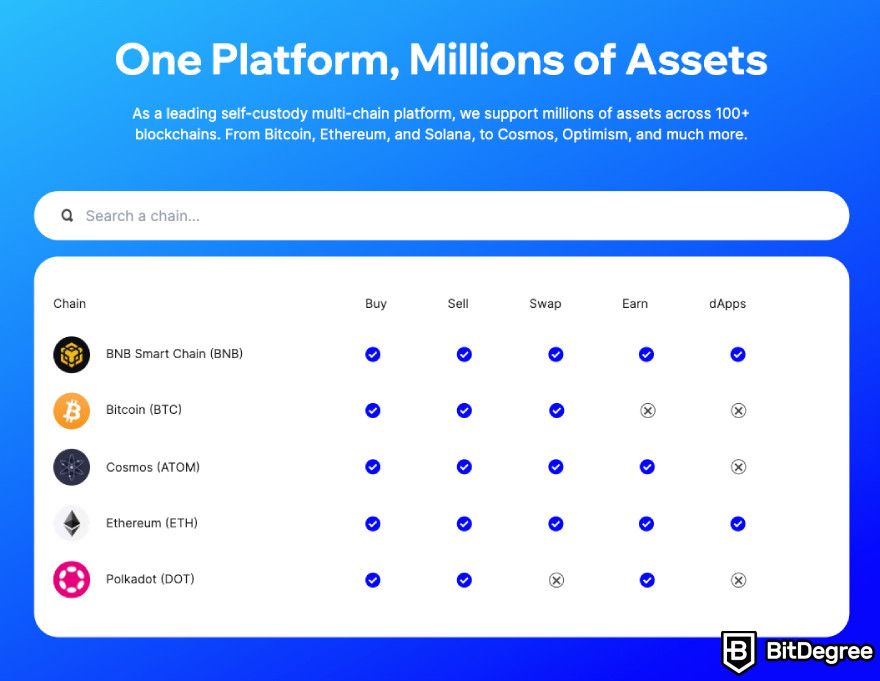
Moreover, Trust Wallet's support for over 100 blockchains empowers users to explore and engage with various dApps across different ecosystems. This broad compatibility ensures that, with the Trust Wallet, you can have access to a myriad of projects, NFT marketplaces, and DeFi platforms, contributing to a rich and multifaceted experience – any Trust Wallet review will acknowledge that.
In the world of crypto investments, diversification is a fundamental strategy to mitigate risks and capitalize on emerging opportunities[2]. Trust Wallet's comprehensive support for a wide variety of digital assets and blockchains positions it as a go-to platform for those seeking to create diversified crypto portfolios.
By offering a unified solution for managing multiple assets across numerous blockchains, the Trust Wallet simplifies the complexities of the crypto landscape and provides crypto enthusiasts with a robust foundation for their investment endeavors.
Latest Ledger Nano X Coupon Found:For a limited time only, get Top-rated Ledger bundles for yourself and your loved ones with a 10% Ledger discount code. Take advantage of this valuable Ledger deal NOW!
Seamless User Experience
The Trust Wallet excels with its user-friendly interface, making it a prime choice for both beginners and experienced users alike. Its simplicity doesn't compromise functionality, offering an intuitive wallet interface that caters to a wide spectrum of experience levels.
For newcomers navigating the world of digital assets, the Trust Wallet goes the extra mile by providing an array of helpful guides and explainers. These resources come in handy, offering clear directions and insights for those who might need a bit of guidance along the way.
Whether you're new to the realm of cryptocurrencies or a seasoned investor, Trust Wallet's approachable design ensures a smooth and accessible experience for all users.
Swapping and Buying Directly Within the Trust Wallet
No Trust Wallet review would ever be complete without mentioning its swapping feature, which enables users to effortlessly exchange various cryptocurrencies directly within the Trust Wallet app or browser extension. The platform boasts an extensive catalog of over 1 million cryptocurrency pairs, providing users with a comprehensive range of options.
One significant advantage of swapping in Trust Wallet's built-in Swap is the reduction in gas fees. By strategically identifying the most gas-efficient liquidity sources for each transaction, the Trust Wallet helps users save on fees. Furthermore, the platform is dedicated to securing the best rates, ensuring that the Swap feature not only grants access to a diverse array of tokens but also guarantees the most competitive prices for transactions.
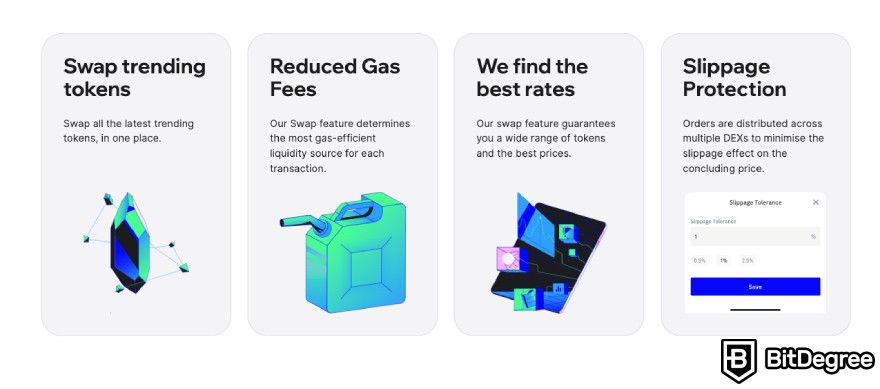
Oh, and don't worry – the Trust Wallet charges no fees on its Swap. You'll still have to pay gas fees (which you can adjust according to your transaction speed goals) and any incurred third-party fees, but none of it goes to the Trust Wallet.
Addressing concerns about slippage, the Trust Wallet implemented robust slippage protection measures. Orders are intelligently distributed across multiple decentralized exchanges (DEXs), effectively minimizing the potential impact on the final transaction price.
Navigating the swapping process within the Trust Wallet is straightforward:
- Initiate the swap option;
- Select the desired asset for swapping;
- Input the preferred swap amount;
- Review the transaction details;
- Proceed by selecting [Confirm Swap].
If you don't have any crypto for swapping, you can also purchase it using fiat directly in your Trust Wallet. The best part is that there's a variety of supported payment methods, including Apple or Google Pay, MoonPay, SEPA, and many others.
All in all, Trust Wallet's user-friendly interface, coupled with its efficient features, ensures a seamless and hassle-free experience when engaging in cryptocurrency swapping and purchases. Through its intuitive approach and reliable functionality, the Trust Wallet emerges as a compelling choice for users seeking accessibility and convenience in managing their digital assets.
In-Wallet Staking Options
Apart from in-wallet swapping, there's also in-wallet staking offered by the Trust Wallet.
By staking your crypto, you're not only expanding your portfolio but also contributing to the security of blockchain networks for all users. It’s a win-win scenario. What’s even more appealing is Trust Wallet’s range of staking options.
With a staggering 20+ options available within the wallet, the possibilities for earning rewards are extensive. That's why many users' Trust Wallet reviews praise that aspect of this wallet.

Staking your crypto through the Trust Wallet is also a seamless process, easily accessible to both beginners and seasoned investors. The simplicity of staking and the array of options make it an attractive feature within the Trust Wallet experience.
Whether you’re aiming to diversify your portfolio or simply seeking additional passive income, the in-wallet staking options offered by the Trust Wallet are certainly worth exploring.
What's particularly user-friendly is Trust Wallet's earning estimator. This handy tool is easily accessible and does the math for you, estimating potential earnings based on the current Annual Percentage Rate (APR) of available assets. It’s a straightforward process that allows users to anticipate their rewards before committing to staking, providing a clear view of the potential benefits.

Did you know?
All Crypto wallets may look similar to you but they're NOT all the same!
Trust Wallet Review: CONS
Within the realm of the Trust Wallet lies a landscape not immune to imperfections. As with any entity navigating the complexities of digital finance, there exist facets warranting scrutiny. Examining the disadvantages of Trust Wallet reveals aspects that, while not devoid of merit, present considerations that a Trust Wallet review could never ignore.
Questionable Legitimacy of Some Supported Crypto Projects
As mentioned before, the Trust Wallet boasts an extensive array of cryptocurrencies. However, this wealth of options can sometimes feel like one of the disadvantages of Trust Wallet, too. With so many crypto projects available, it might become challenging for users, especially beginners, to navigate through the abundance of choices.
So, although this variety was mentioned in "Trust Wallet Review: PROS", it also needs to be listed in this "Trust Wallet Review: CONS" chapter.
One drawback of the multitude of cryptocurrencies is the potential for confusion. New users might find themselves lost amidst the numerous projects, struggling to discern between legitimate ones and those with less value or credibility. This abundance could lead to decision fatigue, making it harder for users to make informed choices about which assets to invest in or explore further.
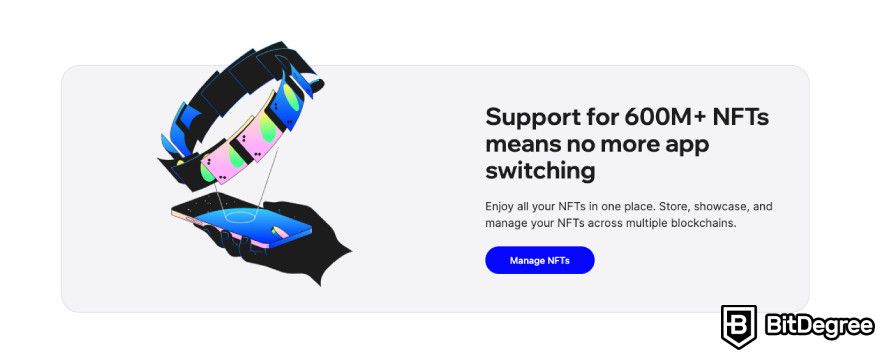
Moreover, the sheer volume of projects also raises concerns about the quality and reliability of some cryptocurrencies available on the Trust Wallet. Not every project may uphold the same standards of security, reliability, or potential for growth. This variability in quality among the listed projects might pose a challenge for users who wish to identify and invest in promising assets.
Despite these challenges, the Trust Wallet continuously strives to enhance user experience and mitigate these concerns. Users can overcome these challenges by conducting thorough research before investing and utilizing available resources, like reviews and community discussions, to identify worthwhile projects amidst the sea of options.
In essence, while Trust Wallet's diverse range of cryptocurrencies is a testament to its comprehensive approach, it may overwhelm users and raise concerns about the quality and usability of the platform due to the sheer volume of options available.
No Two-Factor Authentication (2FA)
Another disadvantage of Trust Wallet is the fact that it doesn't employ two-factor authentication (2FA), which is a fundamental security measure that enhances the protection of user accounts.
2FA acts as an additional security layer, requiring users to provide a second form of authentication, typically a temporary code sent to their registered mobile device or generated by an authenticator app, alongside their password when logging in.
The lack of 2FA in the Trust Wallet exposes users to heightened security risks and vulnerabilities. Without this additional layer of verification, unauthorized access to user accounts becomes comparatively easier for malicious actors.
Though, the absence of 2FA not only increases the susceptibility of Trust Wallet users to unauthorized access, but also amplifies the risk of various security breaches, including account hijacking, fund theft, and unauthorized transactions.
Security-focused users may opt for alternative wallets that provide robust security features, including 2FA, to safeguard their digital assets more effectively. Better yet, they should go with a hardware wallet like Ledger Nano X, which is deemed to be the one of the most secure forms of crypto storage.
Trust Wallet Fees
Now that you know both advantages and disadvantages of Trust Wallet, the time has come to talk about fees in this Trust Wallet review. Luckily, it keeps things pretty clear-cut, so it's easy for anyone to understand their fee structure.
First off, using the wallet itself won’t cost you a dime – no subscriptions, no fees. When you conduct transactions within the app, the Trust Wallet won't add any extra charges, too. However, there's a prerequisite – covering the network fee, which you can adjust as needed.
Regarding swapping crypto, the Trust Wallet maintains its no-fee policy. It doesn't impose additional charges for swaps. Nevertheless, bear in mind the existence of network fees and other third-party provider charges that might come into play. The Trust Wallet doesn't control these fees, though. They're independent elements that might surface during your swaps.
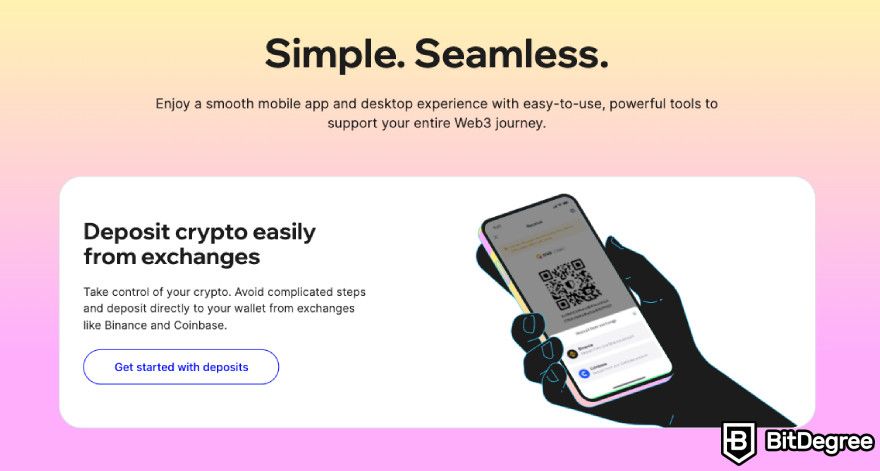
So, how are these swap fees determined? It's a blend of factors – contingent on the network's status during your swap and fees set by third-party providers. The network fee, or gas fee, is utilized by the blockchain to verify your transaction's legitimacy. This fee fluctuates with the network's conditions and isn't collected by the Trust Wallet.
Additionally, there are provider fees, incorporated into the quote you receive for your transaction. These fees don't go to the Trust Wallet either.
If you're considering purchasing crypto with fiat currency, the fees hinge on the involved parties, too. The Trust Wallet collaborates with various payment channels like MoonPay or Ramp, each with potentially varying fee structures. Your location might also impact the fees, so it's about choosing the most suitable option for you.
Regarding staking, the Trust Wallet doesn't levy any fees. However, they utilize external pools for securing yields, which means third-party fees might be involved while you're staking your assets.
So, the bottom line of this Trust Wallet review is that the wallet itself doesn't charge any fees.
How to Create a Trust Wallet?
Let's say you've read this Trust Wallet review and came to the conclusion you want to own your private keys. Then, all that's left to do is create your wallet, right?
Still, you might find yourself confused about how to actually do that. But worry not – creating your Trust Wallet is a breeze, and I'll walk you through the steps needed to set up your own Trust Wallet in just a few minutes.
But first things first: make sure to download the Trust Wallet from its official website. You can download it as a Chrome extension or an app (available for both iOS and Android), but I'll stick to the Chrome version for this guide.
Step 1: Once you've downloaded Trust Wallet's Chrome extension, it'll automatically open in a new tab. In case you closed it, no worries: simply click the [Extensions] menu on your Google Chrome browser (it's that little puzzle piece on the upper right corner) and tap [Trust Wallet]. There, you'll see the option to [Create a new wallet], so go ahead and click it.

Step 2: Create a strong password and accept the Terms of Service. However, before moving forward, take a moment to actually read the Terms of Service. Once you've given them a look, check the box and hit [Next]. Remember, there's no turning back from this point.

Step 3: After deciding whether to share some data or not, you'll be directed to your brand new wallet. Though, this is actually the most crucial part of this guide: it's time to backup your recovery phrase. So, don't ignore that big [Backup your Secret Phrase now] button at the top, please. Go click it before making any transactions!
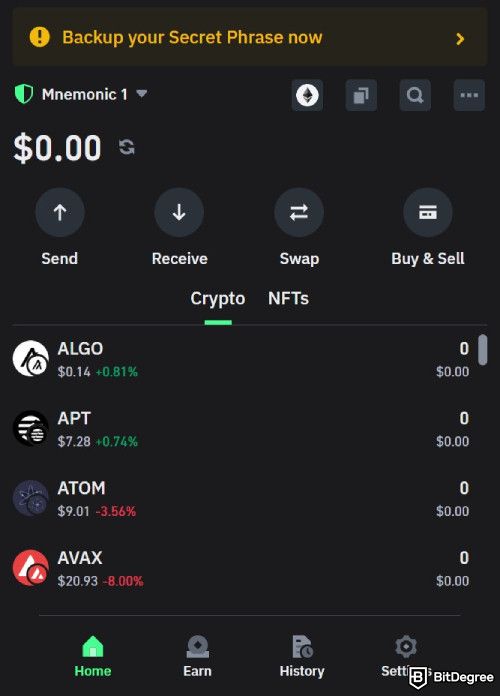
Step 4: Write down your recovery phrase and save it offline – in a safe, in an "important papers" folder, or wherever you feel it'll be best kept. Your recovery phrase is the key to your wallet, so you really need to jot it down and keep it secure. Losing your recovery phrase means losing access to your wallet, so I can't stress this enough! After properly storing it, just go ahead with the process.

Step 5: Verify your recovery phrase. If you've followed Step 4 and backed up your recovery phrase, verifying it is a breeze. Simply select the words in the correct order to complete the process. Click [Continue] when you're done. After the backup and verification process, you'll land on the main wallet screen.
That's it! Your wallet is ready for your crypto adventures. You'll find an initial list of coins ready for funding.
If you want to make your wallet uniquely yours by giving it a name, head to [Settings], tap on [Manage Wallets], and click the three dots to the right of the wallet you want to personalize. Tap [Change wallet's name], type the desired name and [Confirm] your choice.
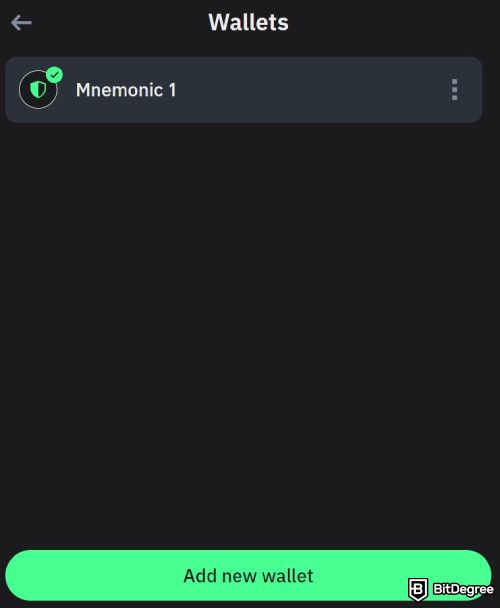
Oh, and you can create up to 15 wallets on the app. To do so, open your Trust Wallet, tap [Settings], then [Manage Wallets]. Hit the [Add new wallet] button and follow the necessary steps.

- User-friendly design
- Robust security
- Long battery life

- A brand-new design
- Industry-leading security
- Coin, token and NFT storage

- Supports 1,000+ crypto assets
- Easy navigation
- Open-source
Conclusions
Wrapping up this Trust Wallet review, it's clear that the platform brings a lot to the table for crypto enthusiasts. Its safety measures and support for various cryptocurrencies and NFTs make it a decent choice. The easy-to-navigate interface and the convenience of swapping and buying within the wallet itself are also major pluses. Besides that, having staking options right in your wallet is pretty neat.
However, it's worth noting that the abundance of crypto projects might be overwhelming for some, and a lot of these projects even have questionable legitimacy. Also, while it does have strong security measures, it doesn't employ one very popular and crucial thing – 2FA.
In case you're looking for a more convenient option, consider using the Binance Web3 Wallet or the Coinbase Wallet. Also, if you're all about security, you should consider getting a cold wallet like Ledger Nano X (don't forget that you can use both – a cold and a hot wallet).
The content published on this website is not aimed to give any kind of financial, investment, trading, or any other form of advice. BitDegree.org does not endorse or suggest you to buy, sell or hold any kind of cryptocurrency. Before making financial investment decisions, do consult your financial advisor.
Scientific References
1. C. Au, K. Law, D. Chiu, et al.: 'Investigating Mainstreaming Strategies of Hot Cryptocurrencies-Wallet';
2. M. B. Osman, E. Galariotis, K. Guesmi, et al.: 'Diversification in Financial and Crypto markets'.




